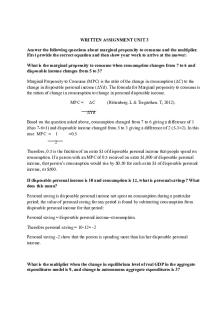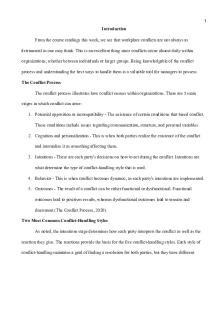BUS 5113 Unit 3 Written Assignment for unit 3 PDF

| Title | BUS 5113 Unit 3 Written Assignment for unit 3 |
|---|---|
| Course | Organizational Theory and Behavior |
| Institution | University of the People |
| Pages | 5 |
| File Size | 203.9 KB |
| File Type | |
| Total Downloads | 973 |
| Total Views | 1,015 |
Summary
Theories that affect motivation BUS 5113 Unit 3 Written AssignmentUnder supervision of Prof. Hillary HodgesIntroductionThere exist many motivation theories that studied the organizational behavior of employees such as Maslow’s Hierarchy of Needs, Herzberg’s Motivator-Hygiene Theory, McClelland’s Lea...
Description
Theories that affect motivation BUS 5113 Unit 3 Written Assignment Under supervision of Prof. Hillary Hodges
Introduction There exist many motivation theories that studied the organizational behavior of employees such as Maslow’s Hierarchy of Needs, Herzberg’s Motivator-Hygiene Theory, McClelland’s Learned Needs Theory, McGregor’s Theory X and Theory Y, Adam’s Equity Theory, Vroom’s Expectancy Theory, and Skinner’s Reinforcement Theory In this paper, I am going to investigate three of these theories and explain how they have increased our understanding of motivation, and going to compare their influences on human motivation. Finally, I will highlight on the theory that best applies to me. Maslow’s Hierarchy of Needs This is the earliest and the most famous theory developed in the 1940s (Maslow, 1943). Maslow summarizes the needs into five main groups, beginning with the basic psychological needs as shown in his pyramid (Fig. 1).
Fig. 1 Maslow’s Hierarchy of Needs (Maslow, 1943)
The lowest unsatisfied need becomes dominant and most powerful. It then activates the people to act to fulfil it. Satisfied needs do not motivate, but drive the people to seek a higher need. The popularity of this theory came from its simplicity and logic. Herzberg’s Motivator-Hygiene Theory This theory is also called the two-factor theory or dual-factor theory (Herzberg, 1964) and (Herzberg, Mausner, & Snyderman, 1959). It states that there are some factors (called motivating factors) that cause job satisfaction, while a separate set of factors (called hygiene factors), that cause dissatisfaction. This is to say that these two feelings are not opposite of each other, because they act independently, as shown in Fig. 2.
Fig. 2 Herzberg’s Two Factor Theory (Herzberg, 1964) Salary and the work environment come in the hygiene factors, while human characteristics such as personal growth and having responsibility or achievement are among the motivating factors. McClelland’s Learned Needs Theory McClelland (McClelland, 1961) describes three human permanent motivators, which are: achievement (a need to accomplish and demonstrate competence), affiliation (a need for
love, belonging and relatedness), and power (a need for control over one’s own work or the work of others). According to this theory, all of us have all of these needs to different extent, but one of them will be dominant in the behavior at any given time. Comparison A brief comparison of the three theories is given in the table below. It is clear from this table that Maslow Hierarchy of Needs is the simplest and straight forward. Maslow Hierarchy of Needs Physiological need Safety and security need Belongingness and love need Self-esteem need Self-actualization need
Herzberg MotivatorHygiene Theory
McClelland’s Learned Needs Theory
Hygiene Motivators
Need for Affiliation Need for power Need for achievement
Conclusion From the above table, I feel that Maslow Hierarchy of Needs applies to my case. In my view, the management can utilize it to care for differences in the needs according to gender, age, culture, religion or other factors.
References Herzberg, F. (1964). The Motivation-Hygiene Concept and Problems of Manpower. Personnel Administration, 27(1), 3–7. Herzberg, F., Mausner, B., & Snyderman, B. B. (1959). The Motivation to Work. New York: John Wiley. doi:ISBN 0471373893 Maslow, A. H. (1943). A theory of human motivation. Psychological Review, 50(4), 370–396. doi:doi:10.1037/h0054346 McClelland, D. C. (1961). The Achieving Society. New York: D. Van Nostrand Company Inc....
Similar Free PDFs

Written Assignment Unit 3
- 4 Pages

Written Assignment unit 3
- 2 Pages

Written Assignment Unit 3
- 2 Pages

BUS 5113 Portfolio Unit 3 Answer
- 5 Pages

BUS 5113 - Unit 5 Discussion
- 3 Pages

BUS 5113 - Unit 6 Discussion
- 4 Pages

BUS 5113 Discussion Unit 7
- 3 Pages
Popular Institutions
- Tinajero National High School - Annex
- Politeknik Caltex Riau
- Yokohama City University
- SGT University
- University of Al-Qadisiyah
- Divine Word College of Vigan
- Techniek College Rotterdam
- Universidade de Santiago
- Universiti Teknologi MARA Cawangan Johor Kampus Pasir Gudang
- Poltekkes Kemenkes Yogyakarta
- Baguio City National High School
- Colegio san marcos
- preparatoria uno
- Centro de Bachillerato Tecnológico Industrial y de Servicios No. 107
- Dalian Maritime University
- Quang Trung Secondary School
- Colegio Tecnológico en Informática
- Corporación Regional de Educación Superior
- Grupo CEDVA
- Dar Al Uloom University
- Centro de Estudios Preuniversitarios de la Universidad Nacional de Ingeniería
- 上智大学
- Aakash International School, Nuna Majara
- San Felipe Neri Catholic School
- Kang Chiao International School - New Taipei City
- Misamis Occidental National High School
- Institución Educativa Escuela Normal Juan Ladrilleros
- Kolehiyo ng Pantukan
- Batanes State College
- Instituto Continental
- Sekolah Menengah Kejuruan Kesehatan Kaltara (Tarakan)
- Colegio de La Inmaculada Concepcion - Cebu








